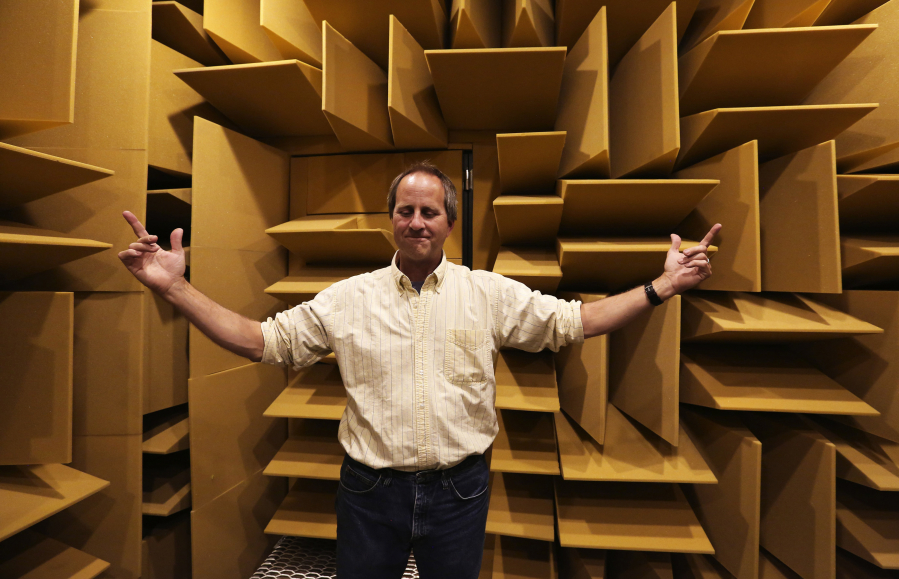ELLENSBURG — Andy Piacsek swings open a bank vault-style door on what looks like a chamber of horrors.
Spiky wedges sprout from the walls and ceiling. Piacsek, a physics professor at Central Washington University, stands on the only flat surface: a metal grating suspended above clawlike serrations thrusting up from the floor.
Injuries are inflicted here, Piacsek confirms — but only to the occupants’ musical sensibilities.
“It hurts my ears,” says Megumi Taylor, a flute player and student who joined Piacsek in the chamber on a recent afternoon. “I don’t like the way it sounds in here.”
The 12- by 12-foot space is so quiet many people find it off-putting. Thick walls and an internal suspension system that’s separate from the rest of the building insulate the room from outside noise and vibrations. The convolution of melamine foam wedges is configured to absorb sounds that originate within the room — like notes from Taylor’s flute — and prevent them from reverberating or echoing.
That’s why it’s called an anechoic chamber, Piacsek explained.
Stripped of the rich resonance created as melodies carom around a concert hall, the result is a dry sound that doesn’t appeal to music lovers but is perfect for scientific analysis.
“If you’re trying to study something that’s making a sound, like a violin or a flute, you don’t want sounds bouncing off the walls that will interfere with your measurements,” Piacsek said.
CWU’s anechoic chamber, part of a new science building that opened last fall, isn’t the first in Washington — and certainly isn’t the biggest or the best. Boeing analyzes aircraft noise in a facility the size of a hangar. Microsoft has three anechoic chambers where engineers fine-tune speakers on tablet computers and speech patterns of online assistants like Cortana. The company’s most advanced chamber recently captured the Guinness record as the world’s quietest room.
But CWU’s more modest facility is the only one at an academic institution in Washington, which means it’s open to researchers across the Northwest.
“I’m hoping our facility can be a regional resource, especially for people interested in musical acoustics — and it’s already starting to happen,” said Piacsek.
Though the CWU facility has only been operational for a few months, researchers from the University of Washington and the University of Puget Sound have used it for projects as diverse as analysis of trumpets to development of a military sound-tracking device.
Piacsek, who plays piano and dabbles in violin, plans to use the chamber to tackle some common beliefs among musicians — such as the contention that a violin that’s been “broken in” through mechanical shaking sounds better than a new instrument.
Rand Worland, who teaches physics at UPS in Tacoma, ran sound tests in the anechoic chamber to investigate the way the shape of a trumpet’s bell affects the sound it produces. One of his students wants to compare different techniques for muting or dampening drums, while another is keen to explore the plunger mutes used to create a wah-wah effect in trumpets and trombones.
“This is a pretty unusual facility for a place like CWU,” Worland said. “I don’t know of anywhere else in the Northwest that I could get access to one.”
Peter Dahl and David Dall’Osto of the UW’s Applied Physics Lab used the anechoic chamber to tackle a military problem: development of a sensitive, inexpensive instrument that pinpoints the direction from which a sound — like gunshots or the roar of a plane — originates by detecting disturbances in air molecules kicked up by passing acoustic waves.
Scientists at Intellectual Ventures, a Bellevue-based lab created by former Microsoft tech guru Nathan Myhrvold, have even more far-out concepts under consideration.
Technologies like sonar for tracking submarines and ultrasound imaging for medicine harness acoustic energy, but it should be possible to boost their effectiveness and create entirely new tools through development of materials that bend and refract sound waves in unique ways, said Intellectual Ventures’s Yaroslav Urzhumov.
Among the applications Intellectual Ventures is exploring for these so-called metamaterials is the creation of focused beams of ultrasound or acoustic energy. Concentrated sound waves can exert a physical force, so beams might be able to disrupt the rotors of drones or possibly even blow up distant objects, in the same way medical ultrasound is used to disintegrate kidney stones, Urzhumov said.
He’s eager to test some of the ideas at CWU. “It’s a natural, symbiotic path, where a university can help you figure out how doable something is, while we are working on how to commercialize things,” he said.
The anechoic chamber, which is the centerpiece of CWU’s new, $1.4 million acoustics lab, is also a great place for students to get hands-on experience with research, Piacsek said.
Taylor, the flute player, conducted experiments to see if strap-on metal plates, marketed as a way to improve the tone of woodwind instruments, really work. She didn’t see much effect, but admits there might have been some variables she wasn’t able to control for.
Trombone player Jace Rowland played his instrument at various angles relative to a microphone to see how directionality affects what the audience hears.
Like Taylor, he doesn’t like to hear himself play in the chamber. “The sound feels like it dies even before it leaves the horn,” he said.
But just being in the room doesn’t freak him out, the way it does some people. When Piacsek took his whole class into the chamber, one student couldn’t stand it and had to leave.
The director of Orfield Laboratories in Minneapolis, whose anechoic chamber held the record as the world’s quietest room before Microsoft, told a British reporter that the longest anyone has ever been able to endure the silence was 45 minutes.
Piacsek said it’s not the silence itself that strikes people most, but the queer lack of reverberation.



